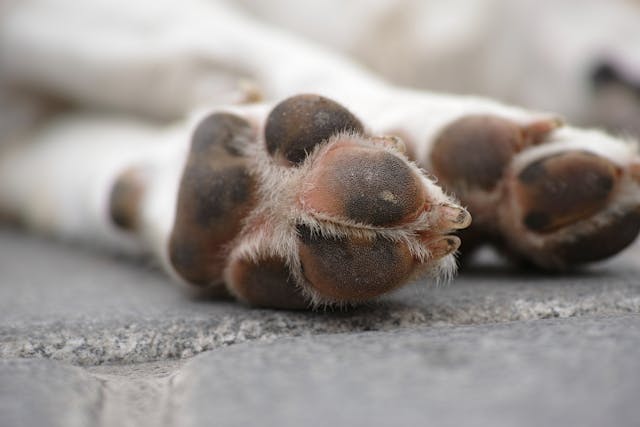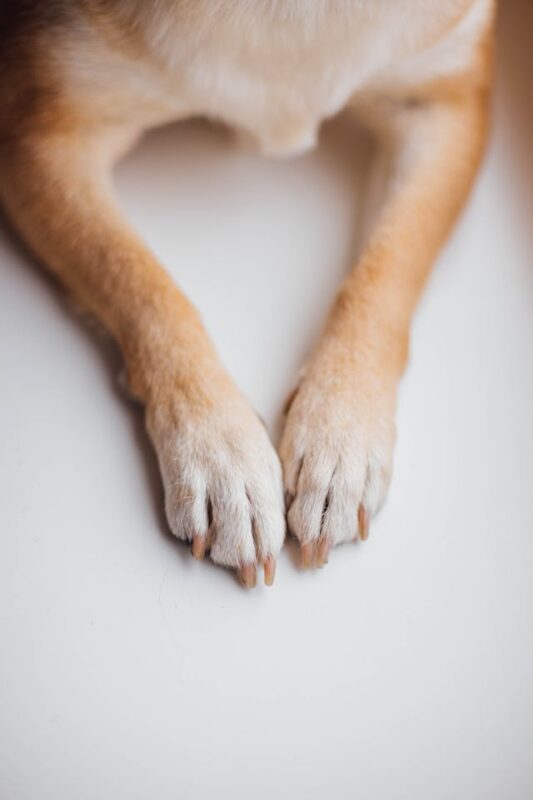Why Are My Dog’s Paws Red?
Posted: 03/03/2025 | BY: Jenna Bruce | Categories: Dog , Health problems , Pet care
If you’ve noticed your dog’s paws looking red, swollen, or irritated, you’re not alone! Many dog parents find themselves asking, Why are my dog’s paws red? It’s a common issue, and while it may seem minor at first, inflamed paws can be a sign of an underlying problem that needs attention.
In this article, we’ll go over all the possible reasons your dog’s paws might be red, how to treat them, and how to prevent future paw troubles. Let’s dive in!

Common Causes of Red and Inflamed Paws in Dogs
1. Allergies (Environmental, Food, and Contact Allergies)
Just like people, dogs can have allergies that cause itchy, irritated skin—including their paws. Allergic reactions can be triggered by pollen, dust mites, grass, certain cleaning products, or even food ingredients. If your pup is licking or chewing their paws excessively, allergies could be the culprit.
2. Yeast or Bacterial Infections
Warm, moist areas—like between your dog’s toes—are the perfect breeding ground for yeast and bacteria. If your dog’s paws are red, smelly, and have a greasy or sticky texture, they may have a yeast infection. Bacterial infections can also cause similar symptoms, often accompanied by pus, sores, or crusty skin.
3. Pododermatitis
Pododermatitis is a general term for inflammation of the paws. It can result from allergies, infections, or even autoimmune diseases. Dogs with pododermatitis often have red, swollen, and painful paws that may be tender to the touch.
4. Burns from Hot Pavement or Ice Melt Chemicals
If you take your dog for walks on hot asphalt in the summer or salted sidewalks in the winter, their paws could get irritated or even burned. This can lead to redness, peeling skin, and pain.
5. Parasites (Fleas, Mites, and Ticks)
Parasites like fleas, mites, and ticks can cause intense itching and irritation, leading your dog to chew or bite their paws. Mange (caused by mites) can be especially problematic, causing hair loss and scaly, inflamed skin.
6. Injuries (Cuts, Scrapes, or Foreign Objects)
Stepping on sharp objects, thorns, or debris can lead to minor injuries that make your dog’s paws red and swollen. If your pup is limping or licking one specific paw, check for any cuts or lodged objects.

7. Autoimmune Disorders
Certain autoimmune conditions, like lupus or pemphigus, can cause sores, blisters, and redness on a dog’s paws. If your dog has recurring or unexplained paw inflammation, your vet may recommend tests for autoimmune diseases.
8. Hormonal Imbalances (Hypothyroidism or Cushing’s Disease)
Hormonal disorders can affect a dog’s skin and paw health. Hypothyroidism, for example, can cause dry, irritated skin, while Cushing’s disease may lead to skin thinning and infections. If your dog has other symptoms like hair loss, weight changes, or lethargy, a vet visit is in order.
9. Overgrown or Ingrown Nails
If a dog’s nails are too long, they can put pressure on the paw pads, causing discomfort and inflammation. Ingrown nails can also puncture the skin, leading to pain and infection.
10. Interdigital Cysts
These fluid-filled lumps form between a dog’s toes and can be painful. They’re often caused by hair follicle infections, friction, or trauma to the paw. Breeds with short, coarse hair (like Bulldogs and Labrador Retrievers) are more prone to developing interdigital cysts.
How to Treat Red, Inflamed Dog Paws
Asking, “why are my dog’s paws red” is just the first step toward helping your pup feel better. Here are some other things you can do to bring some relief to your fur baby.
1. Check for Injuries and Remove Foreign Objects
If your dog is favoring one paw, gently inspect it for cuts, splinters, or lodged debris. Use tweezers to remove any foreign objects and clean the area with a pet-safe antiseptic.
2. Soothe with a Paw Bath
A foot soak with lukewarm water and Epsom salt can help reduce inflammation and kill bacteria. For yeast infections, a 50/50 mix of apple cider vinegar and water (only if there are no open wounds) can help restore balance.
3. Apply a Pet-Safe Moisturizer or Balm
Dry, cracked paws can benefit from a healing balm made with coconut oil, shea butter, or vitamin E. Avoid human lotions, as some contain ingredients that can be toxic to dogs.
4. Use Medicated Shampoos and Sprays
If your dog’s paw redness is due to allergies or infections, your vet may recommend a pet-safe medicated shampoo or antimicrobial spray. These can help control bacteria, yeast, and inflammation.
5. Keep Paws Clean and Dry
After walks, wipe your dog’s paws with a damp cloth to remove allergens, dirt, or irritants. Make sure their paws are completely dry to prevent fungal growth.
6. Adjust Their Diet (For Food Allergies)
If food allergies are suspected, switch to a hypoallergenic or limited-ingredient diet. Work with your vet to determine the best food for your dog.
7. Trim Nails Regularly
Keeping your dog’s nails trimmed prevents unnecessary pressure and injuries to the paw pads. If you’re unsure how to do it, a groomer or vet can help.
8. Use Protective Booties or Paw Wax
If you live in an area with extreme weather conditions, dog booties or paw wax can protect your pup’s paws from hot pavement, ice, and harsh chemicals.
9. Consult a Vet for Persistent Issues
If your dog’s paws remain red, swollen, or irritated despite at-home care, schedule a vet visit. They can prescribe antihistamines, steroids, antibiotics, or other treatments based on the underlying cause.
Why are My Dog’s Paws Red? – The Final Word
Red paws can be a frustrating issue, but with the right care and preventative steps, you can keep your dog’s paws in top shape. If you notice persistent issues, always check with your vet to get to the root of the problem. A happy pup starts with happy paws! 🐾
Protect Your Pup with Pet Insurance
If your dog experiences recurring paw issues, vet bills can add up quickly—especially if tests, medications, or specialized treatments are needed. Pet insurance can help cover these costs, ensuring that your pup gets the best care without financial stress. Consider looking into a pet insurance plan today to keep your furry friend happy and healthy!
Find & Compare the Top Pet Insurance Companies
Get Quotes for Your DogReferences:
- https://ccahweb.com/veterinary-blog/my-dogs-paws-are-red-should-i-call-the-vet/
- https://www.akc.org/expert-advice/health/pododermatitis-in-dogs/
- https://vcahospitals.com/know-your-pet/pododermatitis-in-dogs
Disclaimer
The information contained on this blog is intended for informational and educational purposes only and should not be construed as medical advice. It is not a substitute for professional veterinary care. Always consult with your veterinarian before making any changes to your pet's health care or treatment plan.
The authors of this blog are not veterinarians and do not claim to be experts in pet health. The information provided here is based on our own experiences and research, as well as information from reputable sources. However, we cannot guarantee the accuracy or completeness of this information.
We encourage you to do your own research and consult with your veterinarian before making any decisions about your pet's health.
Previous post
Rimadyl for Dogs: A Pup Parent's GuideCompare top pet insurance providers & plans.
Enter your dog’s age in years and months to calculate their age equivalent to human years.
Calculate your dog’s ageEnter your cat’s age in years and months to calculate their age equivalent to human years.
Calculate your cat’s age

